In this guide, we’re also talking about whether or not blog ads make money still (and how much you can expect to earn based on your traffic levels), so let’s do it.
There’s something really exciting about starting a blog—that feeling you get when you take a creative idea and turn it into something real.
It’s even more exciting when you can turn that blog into a business and begin making real money from blogging. For many people, this combination of doing something they love and making a living (or even just a profitable side business), is well worth the time and energy.
If you’re relatively new to blogging, or you’re looking for more ways to monetize your growing readership, you’ve probably considered running blog advertisements. To be totally honest, there are a lot of different perspectives (and opinion) about blog ads, and while it isn’t personally my preferred method of monetization, there are still plenty of reasons why joining a blog advertising network can be a great move for your business.
If you’re interested in making money through blog ads, I’ve compiled the best blog advertising networks on the market today, so that you can begin better monetizing your content.
9 Best Blog Ad Networks (to Make Money with Blog Advertisements) in 2025
Disclosure: Please note that some of the links below are affiliate links and at no additional cost to you, I’ll earn a commission. Know that I only recommend products and services I’ve personally used and stand behind. When you use one of my affiliate links, the company compensates me, which helps me run this blog and keep all of my in-depth content free of charge for readers (like you).
Quickly, before we dive into this breakdown of the top blog advertising networks on the market this year, I want to answer a couple of pertinent questions. If you want to read my answers, just click on the question to expand—otherwise you can jump right down to the start of our list below.
Why I Don’t Use Blog Ads on My Own Site (Today)
Before chronicling each of the best blog advertising networks, I want to take a few moments to explain why I no longer use blog advertisements here on my site. As a new blogger and over many years I did run ads on my blog, but as I’ve developed my brand and found different strategies to monetize my content, I’ve phased out that portion of my revenue.
For me, it doesn’t make sense to continue using blog ads, though I used them to generate revenue for several years. These are the three main reasons I no longer use blog ads on my site.
1. Blog Ad Revenue is Low Compared to My Other Sources of Income
Perhaps the biggest reason I don’t use blog ads today, is that they don’t pay as well as other revenue sources I’ve invested in building up over my years of blogging.
The revenue you can generate on blog advertisements is pretty low compared to many other sources for publishers in all different types of blog niches and industries. Even at 400,000 t0 500,000 monthly readers, the most I was earning from my blog advertising network was around $1,500 to $2,000 per month. Now don’t get me wrong, $2,000 a month is very real money and can make a meaningful difference in a person’s monthly budget.
It’s nothing to be disappointed about by any means, but as my overall blog revenue began to grow into the $50,000/mo range a couple of years ago, I could recognize that the return on having blog ads placed throughout my content was much lower than what I was earning compared to affiliate programs I recommend to readers and the sale of my own digital products (like my own blogging courses and blogging books) to name just a few other channels.
2. Blog Ads Can Turn Readers Away from Your Content (Bad UX)
This brings me to the second big reason I don’t run blog advertisements anymore. Blog ads never made up a big portion of my blogging income, so it wasn’t difficult for me to part with—but I also realized that the way I was surfacing ads could sometimes be a turnoff to my readers.
I came to the realization one day that personally, I get annoyed with websites that are littered with blog advertisements. So much so, that I usually leave a site and try to go find my answers elsewhere if there are too many ads on the page.
Most people will put up with a well-placed ad that visually fits in with the overall feeling of your blog, but an article overrun with ads can lead to a high bounce rate and fewer return visitors. So while you’re making some income from your blog ads, you may be losing out on making money from other income sources that pay much higher if you instead invest in optimizing your blog for those channels.
3. Blog Ads Can Slow Down Your Website’s Overall Performance
A third major reason I no longer use blog ads, is that it can really affect your page load speeds, leading to what can often be a poor experience for readers and much higher bounce rates. When a website uses ads, it can increase the load time considerably—especially when you have multiple ad placements throughout a blog post.
Every blog advertising network you join will function by injecting some code onto your blog (likely onto every page of your site). That naturally makes the pages of your blog load slower than they otherwise would.
When I did a major blog layout redesign recently, a big decision I made was to optimize everything for ultra-fast loading speeds. I wanted there to be absolutely zero performance-related reasons why readers would bounce away from my blog due to the speed at which my content loads for them.
A long load time can also affect your blog’s SEO best practices, also known as Search Engine Optimization. Slow websites don’t rank as well on Google, and I didn’t want to give any reason why my content shouldn’t be served at the top of Google search results.
If you’re concerned about your page load speeds, use Google’s free Lighthouse tool suite to get actionable insights & advice for where you can improve the performance of your blog.
Quick Breakdown of Why I Don’t Use Ads
All of these factors together made it a no-brainer for me to rebuild my blog around an ad-free experience that:
- Didn’t translate into a significant loss in overall revenue (when compared to the full picture)
- Leads to a better reader experience when consuming my content
- Had clear, measurable benefits in terms of speeding up how quickly my website loads
That’s not to say you shouldn’t consider joining the right blog advertising networks, but rather that my decision was an informed one based on years of experience and the gradual growth of my business here.
Why Blog Ads Might Be a Good Choice for You
I’ve made a pretty strong case for why I don’t use ads on my blog, but that doesn’t mean they’re without benefit. As I’ve talked about above, I used ads on my blog for several years before deciding to turn that revenue channel off.
They can serve a very meaningful purpose—especially for newer bloggers—and may be a good fit for your blog too. Here are some quick reasons why you might want to consider joining a blog advertising network and host tasteful ads on your site:
- It’s easy to get started with blog ads: One of the top reasons to use ads on a blog, is because it’s very simple to get started, implement the placements and start seeing a return (if you have readers coming to your blog). You don’t have to pour any extra work into your blog content, direct people to affiliate links and you don’t have to produce a product of your own in order to make money. Blog ads are one of the easiest ways to start generating revenue from your site.
- It can be a good first step in income: Because it’s one of the easiest forms of monetization, it’s a particularly good choice for new bloggers to experiment with. While you won’t have a ton of visitors on your blog at first, you will be able to make a small return on your traffic—and much more once you really nail your blog marketing efforts. You also don’t have to spend time finding the right affiliates to promote—or on creating content that’s designed to convert well for a particular goal.
- It’s truly passive income: With blog ads, you can collect money simply by driving traffic to your blog. It requires no real additional effort (aside from making sure you continue to promote your blog content and keep readers coming in), and can be one of the most passive types of blog income you can monetize with.
Depending upon the blog advertising networks you choose to join, you can even grow to a pretty substantial amount of income (think $20,000/mo or more) with the right levels of traffic and niche topics your blog covers.
The 6 Different Ways to Get Paid for Blog Advertisements
Payments for blog ads don’t all work the same, and depending upon the blog advertising network you go with, you may be paid based on different blogging goals and structures. Here are some of the different ways that most blog advertising networks determine payouts to publishers:
- Cost-per-click (CPC): When an ad is clicked on your site, you get paid a set amount.
- Cost-per-impression (CPM): Payout is based on a set fee for every 1,000 views an advertisement receives.
- Cost-per-view (watching a video): Similar to the CPM, but specifically focused on people viewing videos—CPV is paid out on platforms like YouTube when you reach a certain number of video views.
- Cost-per-engagement (CPE): Paid when visitors perform a desired engagement, such as engaging directly with an ad.
- Cost-per-action (CPA): Paid when users take a certain action, like purchasing a product or filling out a form to get more information.
- Fixed-rate or flat rate pricing: Payout of a fixed rate fee for placing an advertisement on your blog (usually for a clearly defined amount of time), and you’re paid the same regardless of impressions, actions or engagement levels on the ad.
Most blog advertising networks will pay publishers based on a CPM model that rewards you for the number of impressions their ads receive on your site.
Now, let’s dive into my top picks for the best blog advertising networks to choose from this year. Depending on the status of your own blog, some networks may be more relevant than others. For example, if you have very few readers coming to your blog, you may not qualify for certain networks (yet).
I’ll lay out the requirements for each of these blog advertising networks, as well as their pros and cons—so you can choose the blog ad network that makes the most sense for your goals today.
1. Mediavine
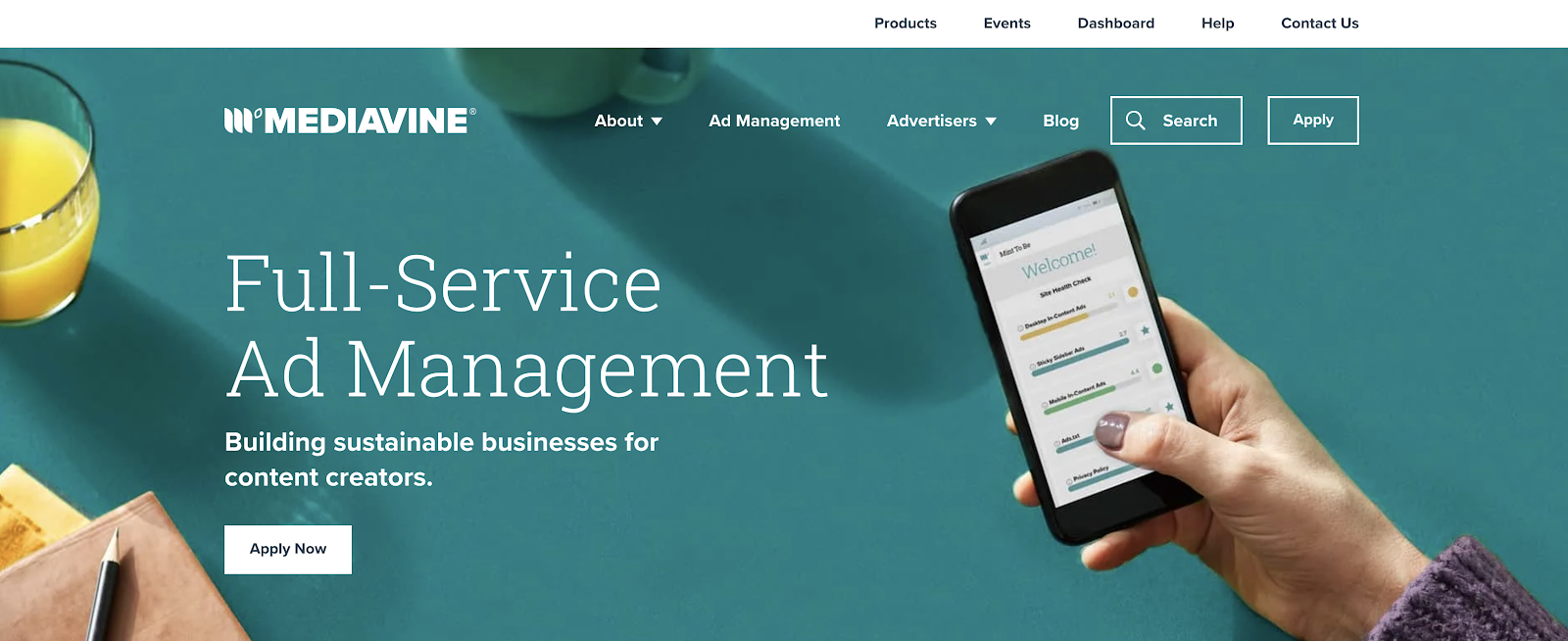
Mediavine is a blog advertising network that was created by content creators, for content creators. They claim that, “Mediavine does the heavy lifting so you can focus on what you do best—creating amazing content.”
Mediavine has been around since 2004, and they work as the middle entity that brokers between content creators and advertisers. As we reach into 2025, they now represent 7,000+ websites that host their blog ads.
Here’s how they explain what they do: “Strictly from an ad management standpoint, we manage your ad server, optimize ad placements, use header bidding and work directly with advertisers on your behalf.”
How to Sign up for the Mediavine Blog Advertising Network
To apply for the Mediavine blog advertising network, you simply have to fill out their application. On the application form, you’ll be asked questions like “what is your site URL?”, “Have you ever applied to Mediavine for this site before”, and “Have you had at least 50K sessions in the last 30 days?”
Requirements to Sign Up For Mediavine
Mediavine has recognized that they’ve seen a spike in interest in their blog advertising network during this past year. So, with the wave of new applicants, they made a choice to adjust their requirements to narrow down the new publishers they’re currently accepting.
Here’s the explanation they gave for making the onboarding process more selective:
“We want to be able to offer even better support, even more tools, and even better ad performance to Mediavine publishers, and to do that, additional resources must be allocated to our existing publishing base rather than onboarding new ones. Raising our minimum traffic requirements is one of the easiest ways for us to get back to our previous, more sustainable growth levels.”
Previously they required 25,000 sessions per month, but they now require 50,000 sessions per month. Mediavine also requires this of new publishers:
- Good standing with Google AdSense
- Original engaging content in any niche
- Long-form engaging content
- Verified “white-listed” traffic (in other words, traffic that’s created by real humans, not bots)
- Content that’s “brand safe” for advertisers
Payments from the Mediavine Blog Advertising Network
Mediavine pays on NET 65 terms, which means they pay 65 days from the end of the month in which your blog advertising revenue was generated. Payments are made on the 5th of the month unless it falls on a weekend, in which case the payment will be made on the closest business day.
Mediavine has several payment methods including:
- ACH International
- ACH USA
- PayPal
- Wire Transfer U.S.
- Wire Transfer non-U.S.
Each year that you stay with Mediavine makes you eligible to get a loyalty bonus. Basically, this just means that your advertising fees raise each year that you work with Mediavine. If you leave Mediavine and return later, your loyalty bonuses will reset.
The minimum payout requirement is $25 for all payment methods except ACH International which is $200.
Pros of Mediavine’s Blog Advertising Network
Mediavine has a few big selling points that rank them as my #1 pick for blog ad networks. Here are some of the best reasons to opt for Mediavine as your blog advertising network of choice:
- Made for and by content creators: Mediavine is a popular choice of bloggers because it’s geared towards content creators.
- Make more with Mediavine: One of the biggest pros of Mediavine is that they pay out more than most of their competitors. Many bloggers report making a much higher return on Mediavine ads than they do using other blog advertising networks.
- Guaranteed payments: Another big advantage of Mediavine is they guarantee their payments. Even if an advertiser fails to pay them or a company goes out of business, Mediavine will still ensure that you get paid what is owed to you.
- Account managers to help: Mediavine offers help to its publishers to increase earnings through adverts.
- Great interface: The Mediavine dashboard was updated just back in 2021 and it’s easy to use and professional.
- Faster load times: Mediavine claims to have initial load times that are 200% faster than their competitors.
Cons of Mediavine’s Blog Advertising Network
If you’re interested in trying out a blog advertising network, Mediavine’s pros far outweigh the cons. However, there are a few things worth mentioning that are not in Mediavine’s favor, compared to some of the other networks we’re breaking down here:
- Comparably difficult to get accepted: The major hitch with Mediavine is its exclusivity. If you’re a new blogger or have less than their minimum number of monthly readers, you won’t yet qualify for Mediavine’s program. They’re very selective with their publishers and have become even more today.
- May not fit your niche: Another potential drawback with Mediavine is their preferred niches. While they’re willing to work with “any niche with quality content” they do tend to work more closely with certain niches. Originally they focused a great deal of effort on food bloggers, but they have widened their circle since then. The bloggers they’re most likely to work with fall into the categories of education, travel, style, fashion, personal finance, home, gardening, hobbies, health, fitness, parenting, arts, entertainment, food and drink.
- Somewhat long wait time for payouts: Blog advertising networks have different terms for payment, but Mediavine’s tends to be on the longer side for return. 65 days from the final day of the month means you’re waiting a good while before you will start seeing money in your bank account.
All in all, Mediavine has more than earned its top spot amongst the best blog advertising networks on the market today—but due to their minimum traffic requirements in order to be accepted, they’re more naturally geared towards working with publishers that aren’t brand new to blogging. If you’re on the newer side still, you’ll want to start with another network first and work your way up to Mediavine.
2. Monumetric
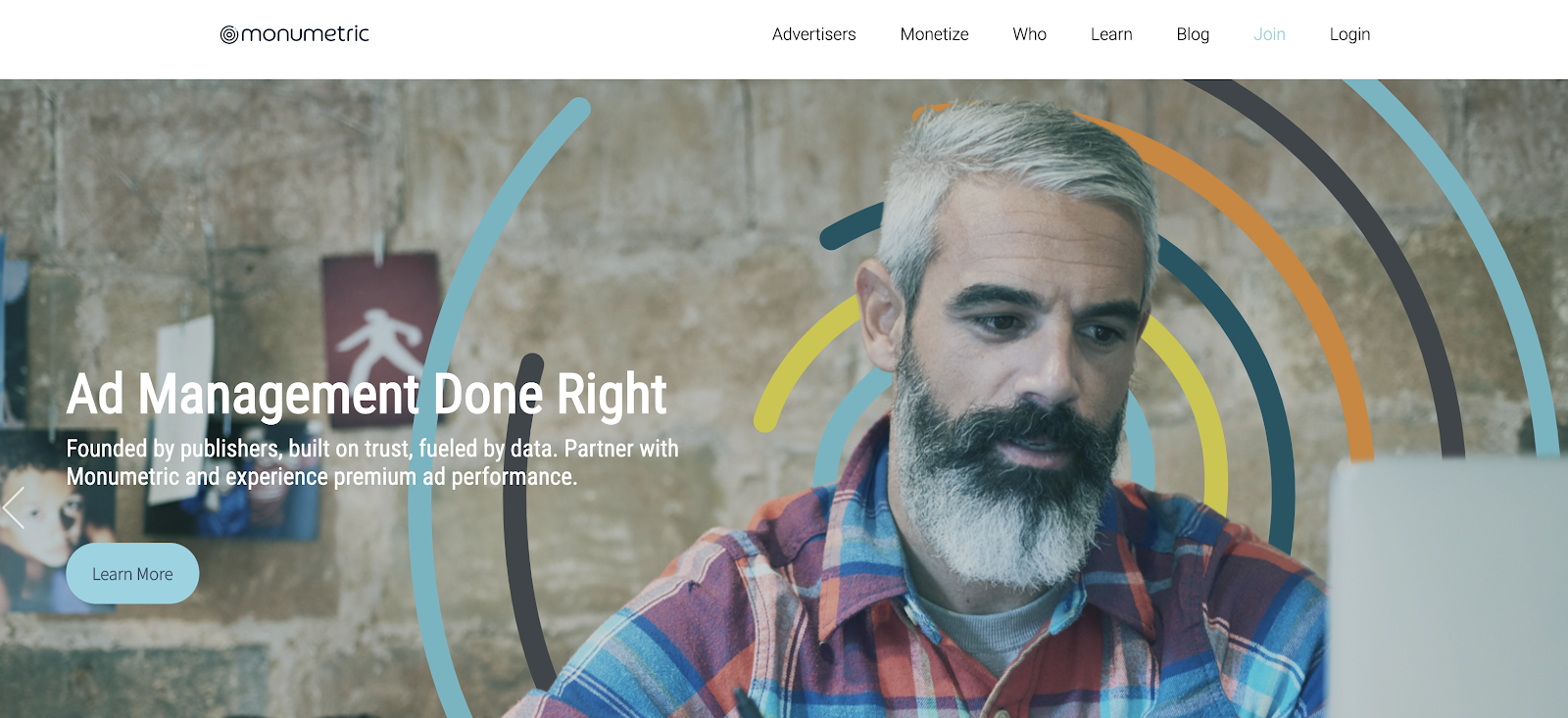
Like Mediavine, Monumetric is another prominent blog advertising network, founded by publishers. This is how they describe the the difference between themselves and other blog advertising networks in the industry:
Founded in 2012, we set out to provide bloggers with an ad-solution that favored the website owner. We had been working with ad-networks for years and were fed up with the lack of reporting, performance, and answers in general. So we started The Blogger Network and quickly became the fastest growing advertising network in the blogging space.
They put an emphasis on transparency and give their publishers useful information that shows exactly how well their blog ads are performing—with a clear focus on providing actionable data.
How to Sign Up for the Monumetric Blog Advertising Network
The Monumetric blog ad network has four tiers of programs based on your traffic volume:
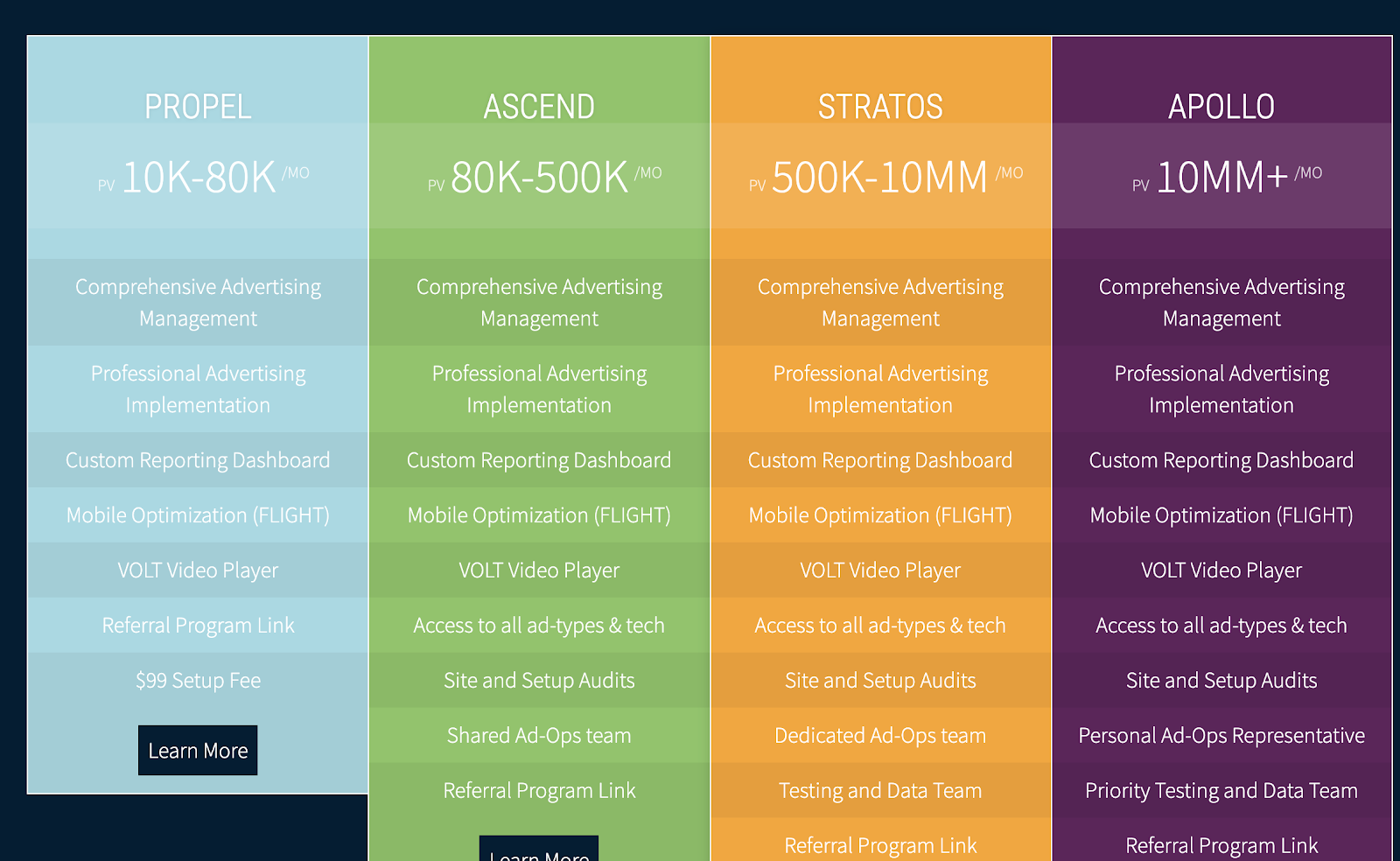
For example, if your blog is getting between 10,000 and 80,000 visitors each month, you’d qualify for their lowest tier program, the Propel range. The application form is at the bottom of the “Getting Started” page, and it looks like this:
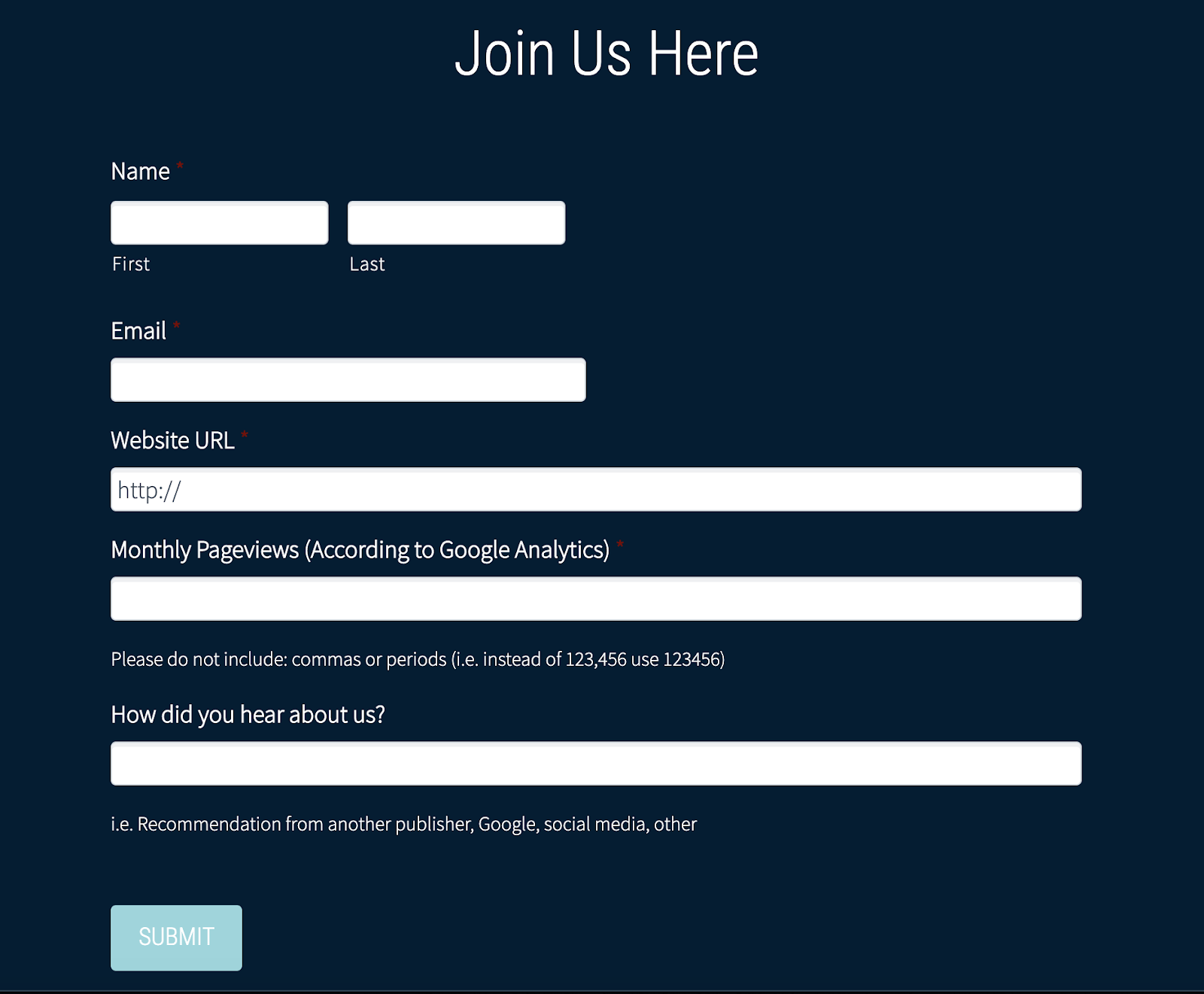
They require some pretty basic information in order to apply and be considered to join their blog ad network.
Requirements for Joining Monumetric
Monumetric has a few requirements in order to be accepted into their program. These requirements include:
- Good standing with Google AdSense
- At least 10,000 monthly page views*
- Original content
- Content that isn’t offensive
- Blog run by either Blogger or WordPress
- Have a sidebar on your pages for ads that’s 300px wide.
- 50% of your traffic from USA, Canada, UK, or Australia
- Must have a minimum of 6 ads per page (in the Propel category)
I recently reached out to Monumetric about their requirements, and they let me know that since the onset of Covid-19, they’ve had an overwhelming amount of applicants and have temporarily raised their pageview requirements for new publishers to be accepted. Here’s what they shared:
“Because of Covid-19, we’ve been inundated with additional applications from publishers hoping to monetize their websites to help supplement their income. Right now we are not able to process sites with less than 35,000 monthly pageviews for at least six months because of the large backlog of applications we have to process through first. We are diligently working through each one in the order in which they were received and are doing our best to get ad approvals for each one.”
Payments from the Monumetric Blog Advertising Network
Monumetric pays on a net-60 payout schedule. You’ll be paid 60 days after the last day of the month of earning. Monumetric pays 75% of advertising fees to publishers.
Monumetric pays through:
- PayPal
- Bank transfer
Pros of Monumetric
- Some control over your blog ads: You can limit ads that might be offensive to your audience. Monumetric automatically blocks what might be considered sensitive categories on their blog advertising network (such as gambling, drugs & supplements, and references to sex). They also allow publishers to block categories, advertisers, or URLs they may be concerned with.
- Great support: Monumetric has excellent support and they have team members that help guide your overall blog strategy for your blog. I reached out to them by email to ask a few questions and their responses were quick and very helpful.
- You choose the pages ads run on: You don’t have to run ads on every page on your blog. You can choose to run ads on specific pages only.
- They add the ads for you: You can put ads in yourself if you choose, but if not, Monumetric will do that backend work for you.
- Higher percentage of ad fees: At 75%, Monumetric pays one of the higher shared amounts of the advertising networks on our list.
Cons of Monumetric
- Startup cost: If your traffic is less than 70,000 visitors a month, then you will only qualify for the Propel program. This program does require a 99 setup fee. If you have a higher traffic volume you won’t be charged this fee.
- Minimum traffic requirement: You must have at least 10,000 visitors a month (or currently 35,000 visitors) to your blog. If you aren’t yet reaching these numbers you won’t be able to use this ad network. It’s also required that half of those visitors come from the US, UK, Australia, or Canada.
- Application process may take time: Once you apply to Monumetric, it may take awhile before you hear back about whether or not you’ve been approved.
- Longer wait times for payment: It’ll take 60+ days after your first month of running ads to get your first payment.
3. Google AdSense
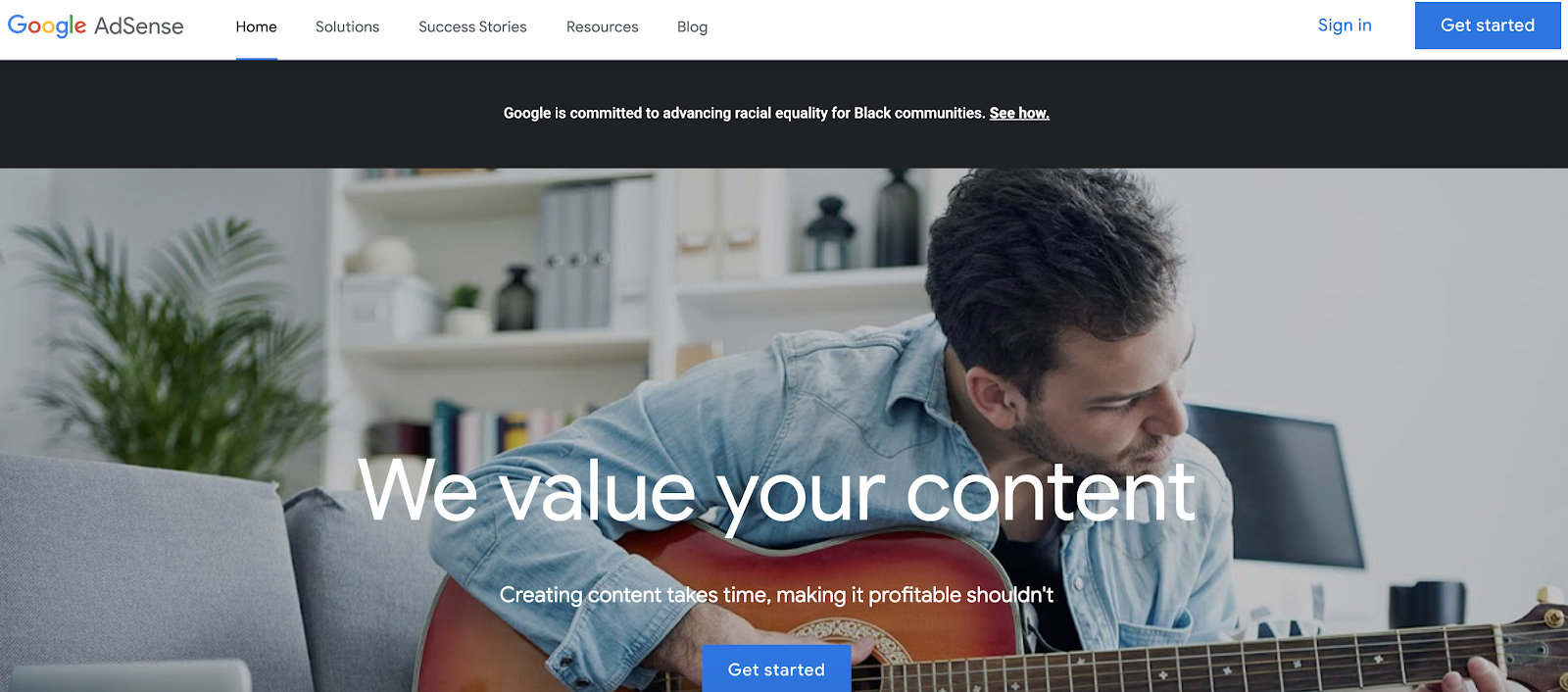
Google AdSense is usually the first (and one of the oldest) blog ad platforms that people sign up for when they’re trying to monetize their blogs. It’s easy to join, doesn’t have any traffic requirements, is operated by one of the largest companies in digital advertising—and is already widely known.
Here’s what you need to know about Google AdSense if you’re considering it to run blog ads on your site.
How to Sign up for Google AdSense
To Sign up for Google AdSense, simply head over to their main page and select “Get Started.” This will get you started on the process of starting an application with Google AdSense (via of course, a Google Form).
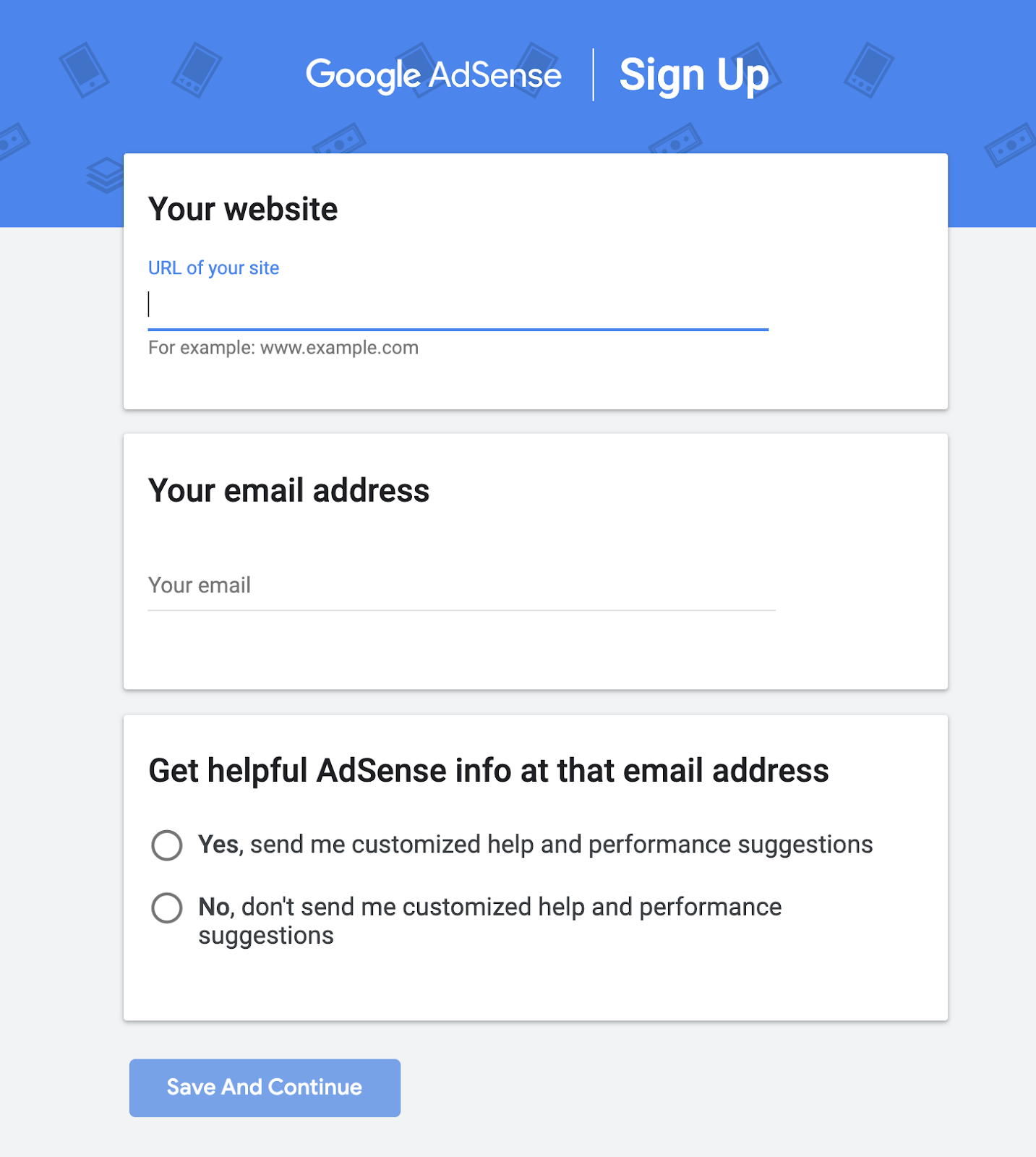
It’s a very simple process to get started, but if you have additional questions they have a tutorial to help you along the way.
Requirements for the Google AdSense Blog Advertising Network
To sign up for Google AdSense, there are only a few requirements:
- A website with unique and interesting content
- Content that complies with AdSense Program Policies
- The owner of the website be at least 18 years old
- Unofficially, your site must be 6 months old (brand new sites might be rejected)
There’s a chance of being rejected by Google AdSense if you don’t meet some of these requirements to participate in their blog ad network, so just be aware. Also, make sure you’re familiar with Google’s ad rules and beware of Google’s two-click penalty for publishers—it can often go unnoticed if you don’t monitor your website ads’ performance closely. Some of the major reasons include not having original content, having very little content, or having duplicate content.
Payments from Google AdSense
Google AdSense pays 68% of their advertising fees to publishers. For example, if they make $100 from an advertiser, they’ll pay the publisher $68. Here’s a little more detail from their explainer :
For display ads with AdSense for content, publishers receive 68% of the revenue recognized by Google in connection with the service. For AdSense for search, publishers receive 51% of the revenue recognized by Google. These percentages are consistent, regardless of a publisher’s geographic location, and are not in any way averaged between publishers.
AdSense pays monthly and issues payment between the 21st and the 26th of the month. If “you accrue estimated earnings over the course of a month, and then at the beginning of the following month your earnings are finalized and posted to your balance on your Payments page.”
Payment methods are determined by location in the world, but some of the provided methods are:
- Checks
- Electronic Funds Transfer (EFT)
- EFT via Single Euro Payments Area (SEPA)
- Rapida
- Wire transfer
Payment thresholds vary based on the type of payment method you choose, but for most types of publisher on this blog advertising network, $100 must be reached before you get paid out.
Pros of Google AdSense
Google AdSense is often the first stop for many bloggers largely because Google is so well known—and because it’s simple to apply. Here are some of the pros for working with Google AdSense:
- Easy to sign up: Though not everyone who applies to Google AdSense gets approved, the process to sign up for their blog advertising network is pretty easy and many people who are new to blogging are able to use Google AdSense.
- Works on multiple sites: If you sign up for Google AdSense you can run ads on several sites based on one account. This can be a helpful thing if you’re running multiple blogs and want to run Google ads on all of them.
- Ads are customizable: You can change the size, color, and location of ads to suit your website.
Cons of Google AdSense
- Higher payment threshold: To get paid through Google AdSense you often have to wait until you’ve made $100 or more to get your money. This may take a while if you’re a new blogger or have low traffic.
- Accounts get shut down: Google AdSense can be particular about their policies, and even well-meaning bloggers have been kicked out of the program without realizing they were in violation of a policy. This can be a big loss of income for a blogger if they are suddenly shut out of the program, and many have reported that once you’re removed it can be nearly impossible to get back in.
- Not everyone is approved: Getting approved for Google AdSense is not a very clear process. While many many people are approved, some people are not approved upon their first application process. For best results, it’s good to review their program policies and terms of conditions to make sure that your site is in sync.
4. PropellerAds
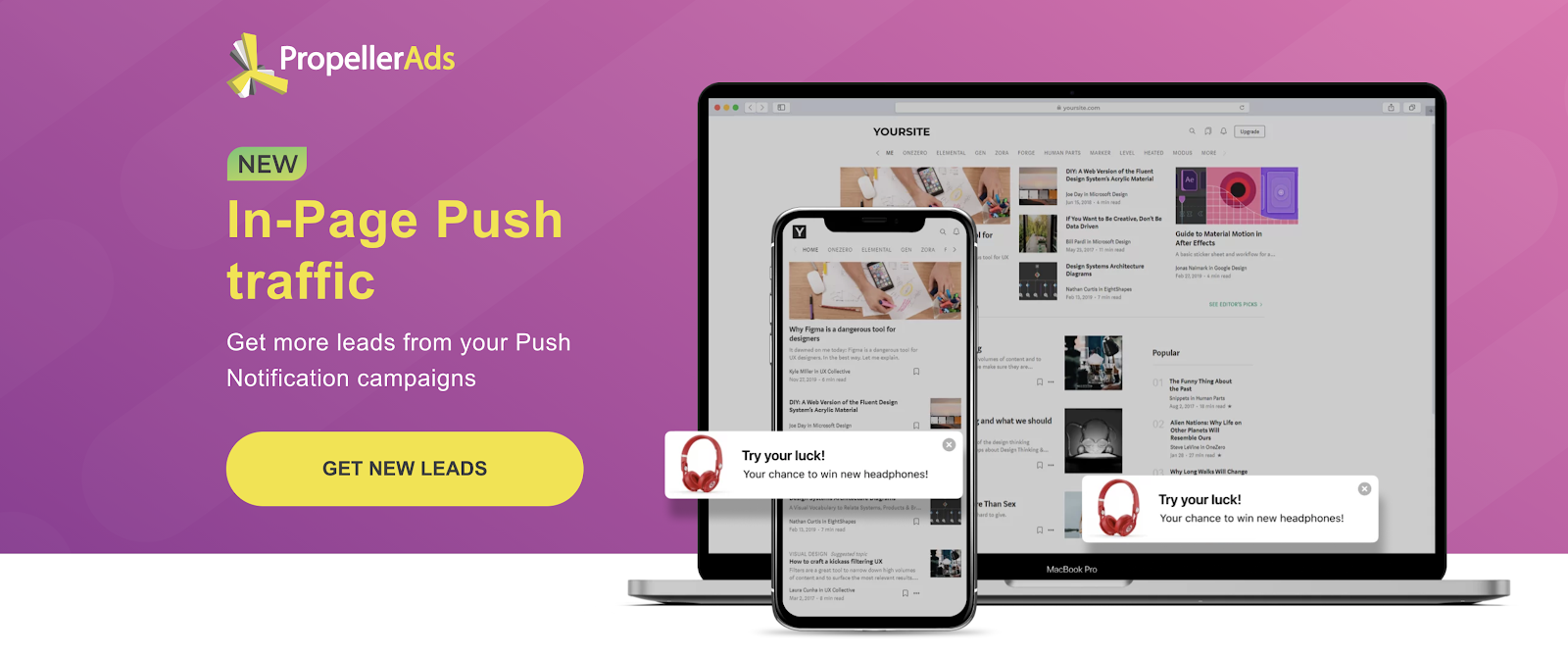
PropellerAds is a blog advertising network originally founded in 2011, which now reaches an audience of over 1 billion people with their advertisements, through more than 70,000 monthly ads and 25 million monthly tracked conversions. They work with over 150,000 publishers (and bloggers) based around the world.
How to Sign up for PropellorAds
To sign up for PropellorAds, go to their registration page and choose the “I’m a publisher” option.
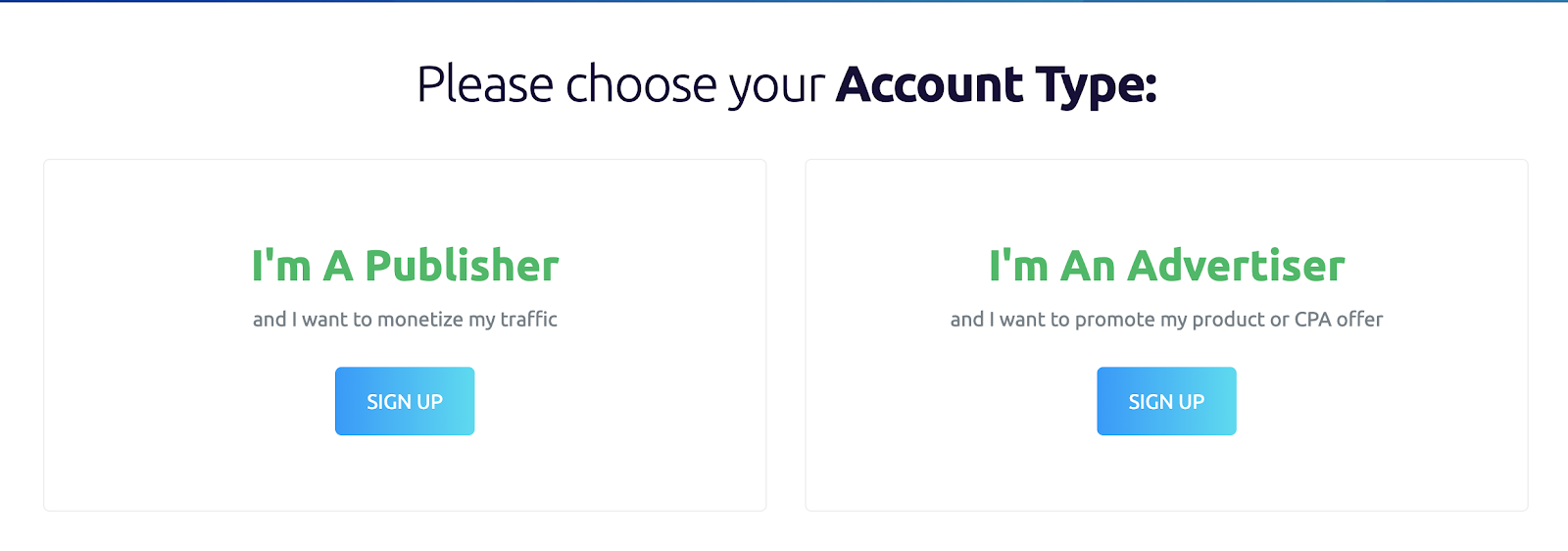
From there, you’ll be taken to an application page that asks informational questions like your name and address. Once you submit the information you will have to wait for an email from PropellorAds. When you receive the email you can follow a link to activate your account.
Requirements to Sign Up for PropellorAds
PropellorAds is very easy to sign up for and they have pretty relaxed requirements. Here’s what they say about it:
Unlike other advertising networks that require your website to meet certain requirements, one of our unique features is it’s super easy to get started. Your account is activated as soon as you sign-up and can start earning within minutes.
We accept all websites that meet our relaxed terms and conditions. Whether you created your website today and only have a handful of visitors, or bring thousands of unique views each day—you can call PropellerAds your new home.
Payments from the PropellerAds Blog Advertising Network
In 2018, PropellorAds began paying weekly. New users will see their first payment (once reaching the minimum payout amount) 14 days after impressions start coming in.
The minimum payout is $5, so even if you make a small sum of money, you can cash in on it with this blog ad network.
Payments are automated, so you’ll receive your payment by your preferred payment method every Thursday (so long as you’ve made money through your blog). The payment methods offered by PropellerAds include:
- PayPal
- Payoneer
- ePayments
- Skrill
- WebMoney
- Bank wire
The minimum payment for PayPal, ePayments, Skrill and WebMoney is $5. For Payoneer, it’s $20, and you’ll have to make $500 before you can have your money sent via wire transfer.
Pros of PropellerAds
PropellerAds has a few big things going for it making it a solid choice as a blog advertising network. Some of those pros are:
- Easy to sign up: You don’t have to have a minimum number of view or sessions to your website before you can qualify for PropellerAds. This feature makes it a good choice for new bloggers who don’t have a lot of traffic coming into their blog.
- Can be used all over the world: PropellerAds claim to be available worldwide — not only for English speaking countries.
- Compatible with Google AdSense: The PropellerAds platform works with Google AdSense.
- Payment is quick: PropellerAds pays quickly and the payout threshold is low. You won’t have to wait around for a long time waiting for your first payment with PropellerAds (assuming you had enough impressions to start making money).
Cons of PropellerAds
- Lower payment for non-English speaking sites: PropellerAds pays less to websites written in non-English languages.
- Not the best user experience: PropellerAds can be low-quality and their popups can be intrusive and annoying to users.
- No header bidding: Header bidding gives publishers the ability to offer ad spaces out to numerous advertisers to bid on to get a higher fee. PropellerAds doesn’t use header bidding which can result in lower fees.
5. Infolinks
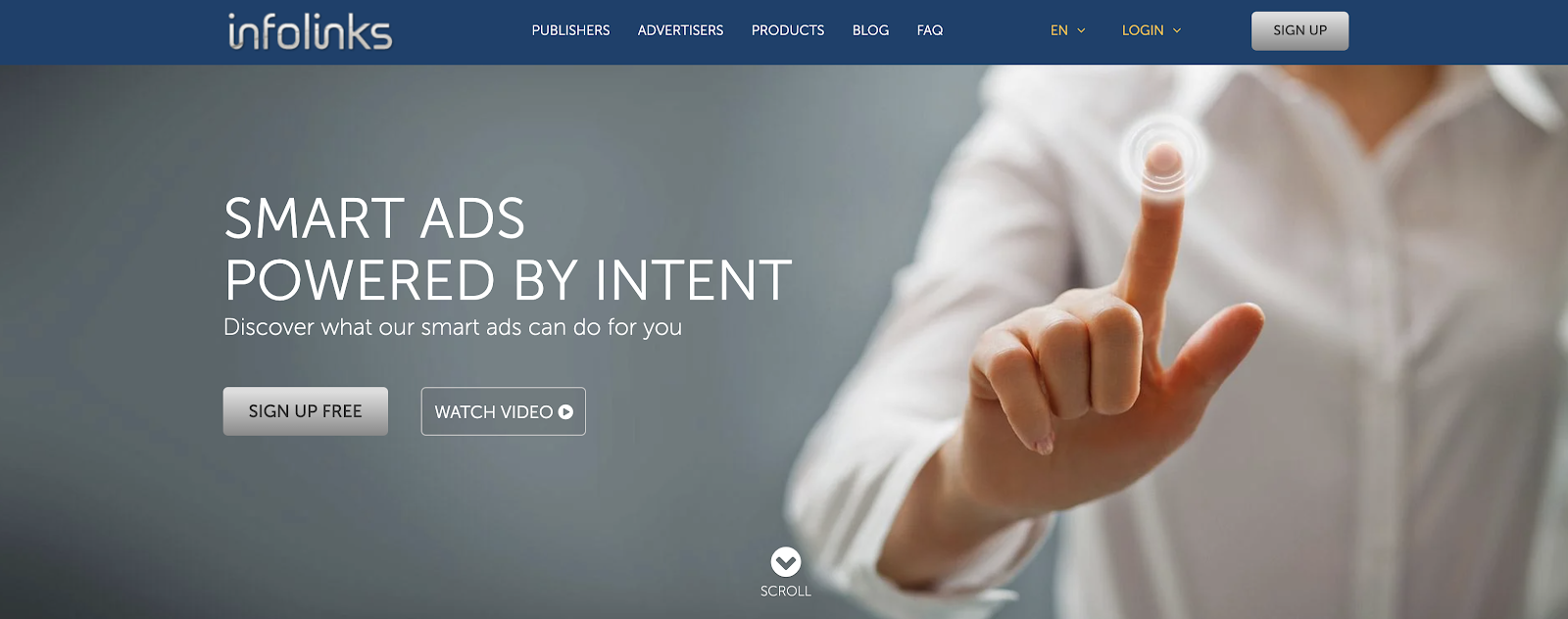
Infolinks was founded in 2016 and is geared towards helping publishers match up with global advertisers. According to Infolinks, they’re the third-largest publisher marketplace in the world—making them a pretty formidable blog advertising network, albeit comparably new to the industry.
How to Sign up for Infolinks
To sign up for the Infolinks blog advertising network, select the publisher tab and click the “sign up free” button. From here you can choose to sign in with Facebook or by email:
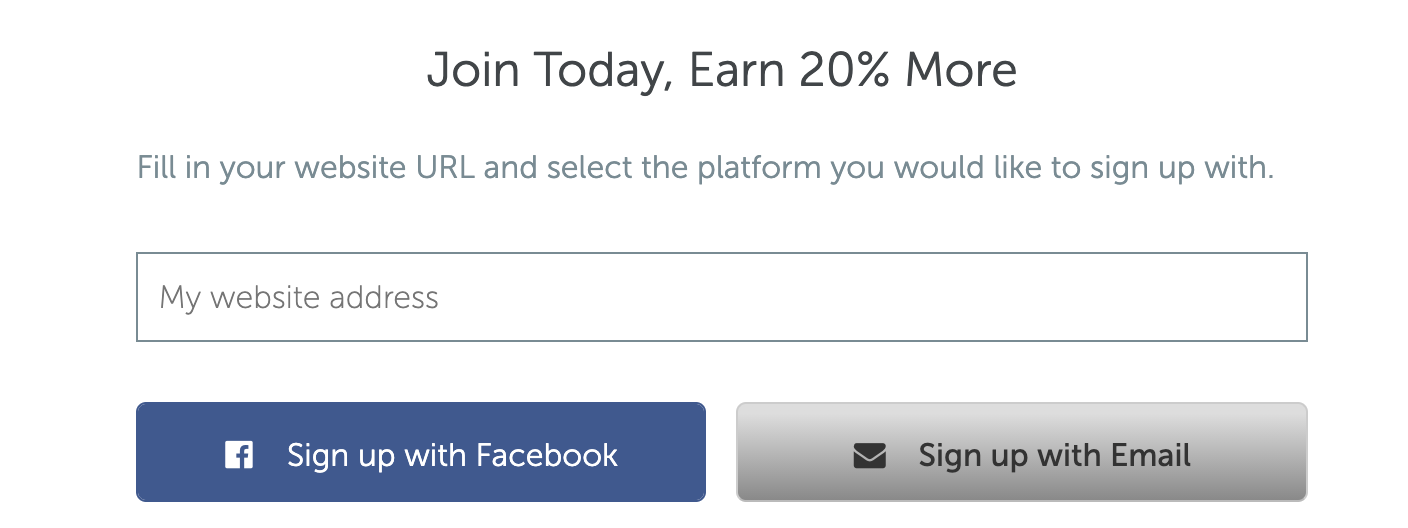
Once you sign up, you’ll have to wait while they review your site. It takes a few days for you to officially get your approval.
Requirements for the Infolinks Blog Advertising Network
Infolinks works with all publishers from small to large sites and they have no minimum page views or visitors thresholds. A few reasons your blog may not be approved is if it includes content that matches any of these criteria:
- Violent images or messages
- Promotion of discrimination
- Promotion of illegal activities
- Adult, obscene, or pornographic material
- Online gambling
Payments from Infolinks
Infolinks pays a 65% revenue share. Infolinks “issue(s) payments no later than 45 days from the end of the month that you reached the minimum payment threshold for your preferred payment option.”
Infolinks offers several payment methods including:
- PayPal
- Bank wire
- eCheck
- ACH (for U.S. bank accounts)
The minimum payment threshold for payment is $50 on the Infolinks blog ads network.
Pros of Infolinks
- Easy to apply and get accepted: Infolinks is one of the easiest advertising networks to get approved by. There are no minimum traffic requirements and the application process is extremely easy.
- Different ad options: You can choose from a variety of ad types including in-frame, in-text, in-fold, and in-tag. Ads can also be customized.
- Use with other ads: You can use Infolinks blog ads alongside other ads like Google AdSense.
- Advertisers in many niches: Infolinks is a large company that has access to many different industries, meaning it’s able to pretty accurately match up advertisers that make sense for your content.
Cons of Infolinks
- Lower earnings: Infolinks doesn’t pay as much as some of its competitors.
- Even lower earnings for non-US countries: There’s a preference for US-based traffic, so your payment will be lower if your traffic is coming from other countries.
6. Ezoic
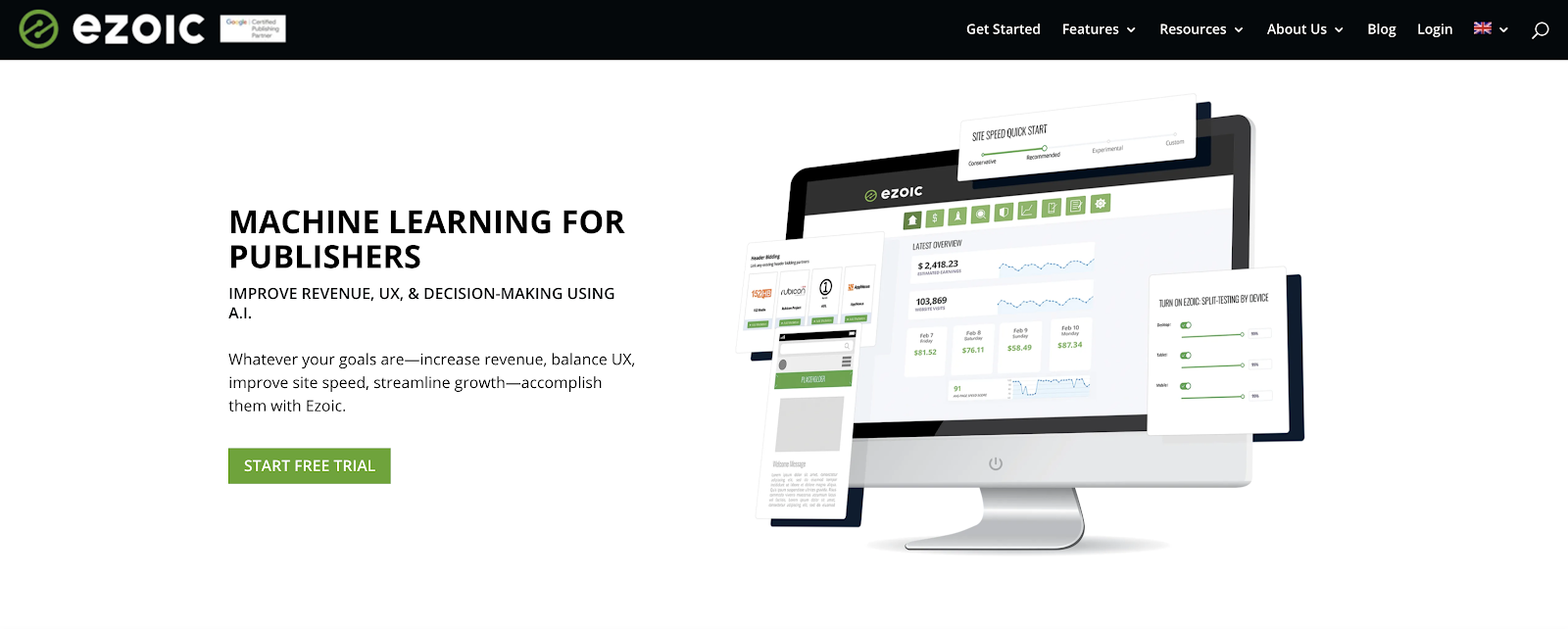
Ezoic is a leading blog ad network founded in 2010 by the former CEO of the first Facebook advertising network, Dwayne Lefleur. This blog advertising network was built for publishers under the concept that content creators could earn more revenue by providing their visitors with a better experience.
Over the past 10 years, Ezoic has tried to help publishers develop a better user experience and earn more money through advertisements. To date, more than 10,000 websites use Ezoic. However, it should be noted that Ezoic doesn’t define itself as an ad network. Here’s how they explain their blog advertising platform:
So what is Ezoic? Ezoic could be compared to a company like Adobe, which is a platform with multiple products for design and media. Ezoic is a platform with multiple products for publishers. Ezoic is often mistaken for the above because many publishers see the value they receive from Ezoic as purely ad revenue.
How to Sign up for the Ezoic Blog Advertising Network
To get started, select the top menu “Get Started” tab. This will take you to an account sign up where you can put in your website, email and password.
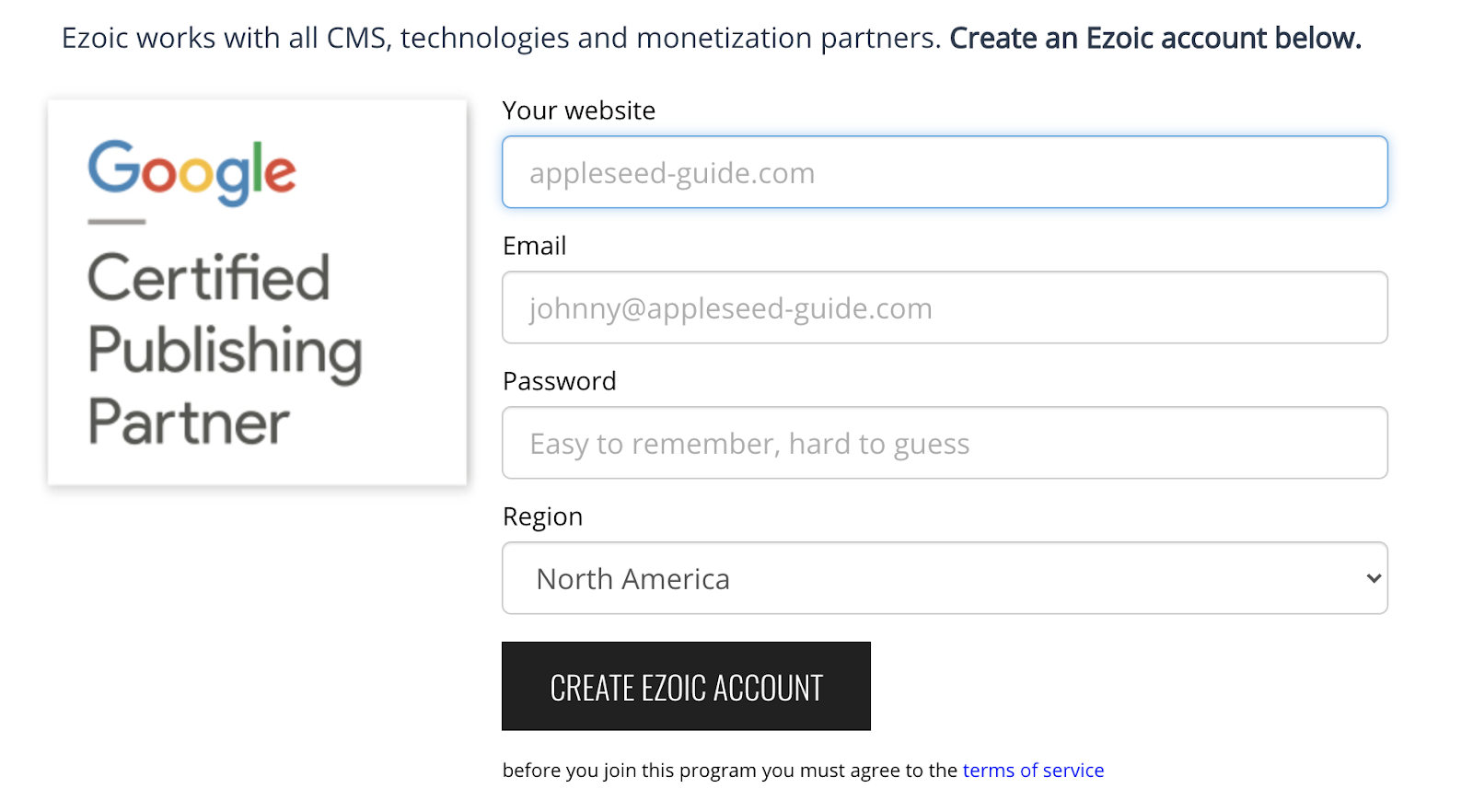
Requirements to Sign Up For Ezoic
Ezoic has a few requirements they recommend for bloggers considering applying:
- An average of 10,000 sessions per month
- Adhere to Google’s Ad Policy
- Create original content
- Track record of traffic
- Good standing with Google AdSense if you have an account with them or Google Ad Manager
Payments from the Ezoic Blog Advertising Network
Ezoic makes payments 45 days after the end of each month when services were used. In order to receive payment, you must accrue a balance of at least $20. However, Ezoic also advertises their payments as net-30.
They explain that while it may take as long as 45 days, it’s more common to be paid at the 30-day mark. Ezoic payment methods include:
- Check
- PayPal
- Direct Deposit
- International Wire Transfer via Payoneer
Pros of Ezoic
- Easy to set up: You can create an Ezoic account very quickly by answering a few simple questions.
- Affiliate program available: You can earn money by referring other people to Ezoic through their affiliate program.
- Ad testing available: Ezoic allows you to do automated testing to see which ads are the most lucrative on your site. It tests many different combinations of ads to find the one that works best for your site.
- Great analytics:The Ezoic user dashboard provides a lot of detailed information about your ads including page views, bounce rate, average engaged time and earnings per thousand visitors (EMPV).
- Great customer service: Many users report Ezoic’s customer support as being responsive and helpful.
- Accepts traffic from all over the world: You have to have 10,000 visitors a month to your website, but Ezoic isn’t particular about where that traffic comes from. You don’t have to have US-based traffic to qualify.
Cons of Ezoic
- Ezoic ad placement: If you want to use Ezoic for free, they’ll place a small advertisement for themselves at the bottom of your page and they’ll collect all the revenue from that ad. You can also choose to pay a 5%-10% fee to remove the ad. This really isn’t a major con, however, since you’re allowed to keep 100% of your advertising fees for remaining ads on your site. Even at 5-10%, you’re still getting a bigger portion of the fees than most ad networks.
- Minimum traffic requirement: You have to have at least 10,000 visitors a month to qualify which could exclude new blogs or blogs with lower traffic volumes.
- A learning curve to using Ezoic: There’s a bit of a learning curve with Ezoic and may take some time to master.
7. Media.net
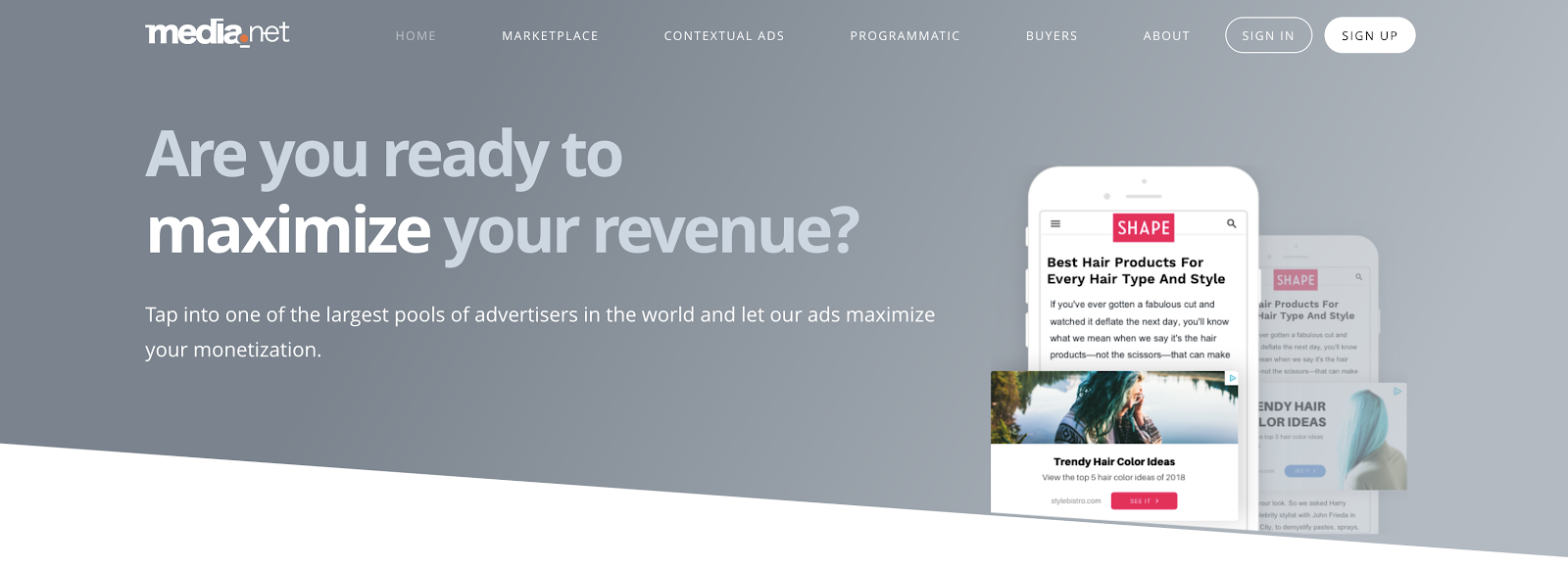
Media.net is a long-standing blog ad platform with a focus on developing cutting edge advertising technology. They manage ads on over 500,000 websites around the world and are one top 5 largest ad tech companies on the market today.
This is how they describe the way they set their advertising apart from other ad networks—”We build products that auto-learn and optimize to display the most relevant ads and offers, in formats that provide a balance of user experience and revenue, while also providing industry leading user privacy protections. This creates long-term sustainable value and, at the same time, maximizes publisher revenue and provides high ROI to advertisers.”
How to Sign up for the Media.net Blog Advertising Network
To get started, go to Media.net’s homepage and type your information into their sign up form:

They claim that you can get started in less than 10 seconds on their blog advertising network—I’d argue you should account for a little more time in order to get things fully set up, though.
Requirements to Sign up for Media.net
Media.net has a list of guidelines that are outlined under their program guidelines. I’ll mention a few here, but you can check out their page for the complete list.
Their program is only open to websites that:
- Contains a significant amount of original content, is updated regularly, and doesn’t infringe on third-party intellectual property rights
- Receives the majority of its traffic from the US, UK or Canada
- Content that is written primarily in English
- Have a reasonable amount of visitors using the website (it doesn’t specify an amount)
- Does not contain excessive advertising
Payments from the Media.net Blog Advertising Network
Media.net pays its publishers on a net-30 basis. Payouts are made only when publishers have made at least $100 in earnings. All payments are made through Payoneer or Wire Transfer.
Pros of Media.net
- Free to join: It doesn’t cost anything to use Media.net.
- High Revenue Per Thousand Impressions: Media.net is known for having higher RPM than many other advertising networks including Google AdSense.
- Contextual ads: Media.net uses something called contextual ads that show users only ads they might actually be interested in which leads to a higher click rate.
- Great customer support: When you join Media.net you will be assigned a customer service representative that will help you through the process or with any questions you might have.
- Can be combined with other ad networks: You can run Media.net ads simultaneously with Google AdSense ads.
Cons of Media.net
- Delayed earning results: You won’t see your earning results in real-time. Instead, you have to wait 24 hours to see results.
- Traffic from the US, UK or Canada: Media.net requires the majority of your traffic to come from these three countries and for the content to be written in English making this a poor choice for bloggers from non-English speaking countries.
- May not be a good fit for all niches: Some niches report making less money through Media.net while others report making more, so be sure you choose your blog name and topics wisely.
8. AdThrive
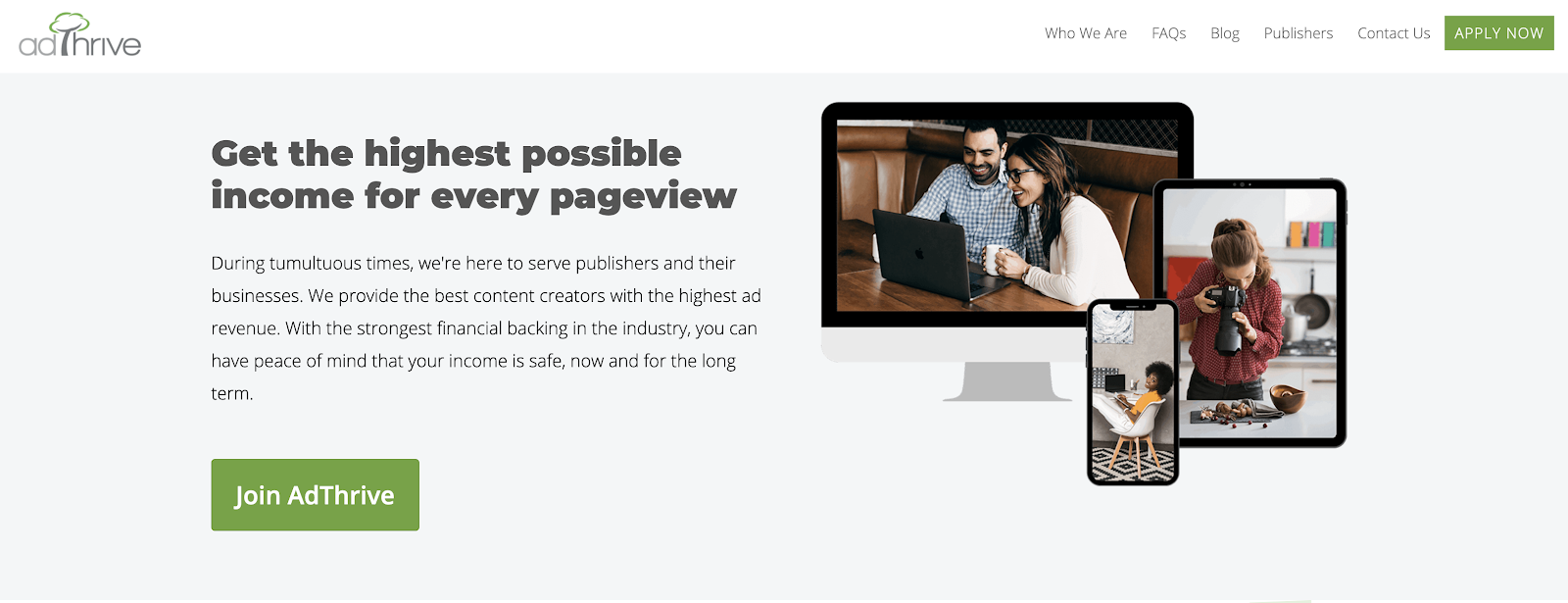
AdThrive was founded in 2013 by a blogging husband and wife couple that, as content creators themselves, wanted to work with other bloggers to help them create a more substantial online income.
How to Sign up for the AdThrive Blog Advertising Network
To sign up for the AdThrive blog ad network, find one of the multiple sign up buttons on their main page to get to their application page. At the top of their main page, they have “apply now” or “Join AdThrive.” Either one will take you to this page:

Choose “Start an Application” and you can then begin the application process for this blog advertising network:
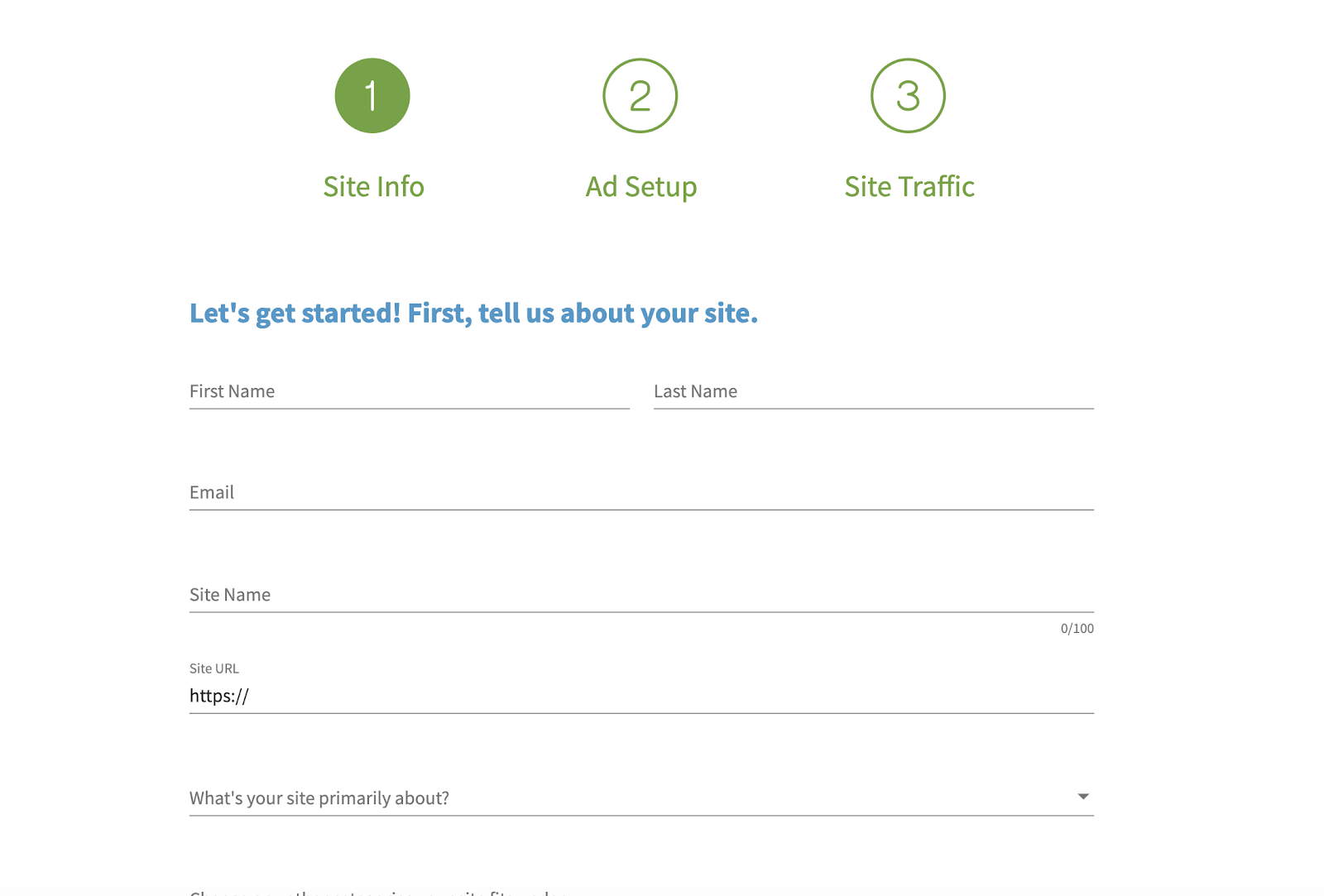
Once you sign up for their blog ad platform, they’ll send you an email detailing the next steps.
Requirements for Joining AdThrive
AdThrive has a few things they require from their publishers.
- At least 100,000 monthly pageviews recorded through Google Analytics
- Majority of the traffic from the United States
- No previous advertising infringements with major ad providers
- Original, unique, and engaging content that fits their advertisers
- Site secure with HTTPS
- Minimum of 3 ads running on highly viewable locations
Payments from the AdThrive Blog Advertising Network
AdThrive shares 75% of ad revenue with their publishers on their blog advertising network and they pay on a net-45 schedule. Payment methods include:
- Direct deposit (Domestic ACH) – US
- eCheck/Local bank transfer
- PayPal
- Paper check
- Wire transfer in the US
- Wire transfer, non-US- paid in USD
- Wire transfer, non-US – paid in Non-USD
The payment threshold is $25 for all payment methods except wire transfer, which has a $100 threshold. Non-USD payments charge an exchange fee.
Pros of AdThrive
- AdThrive payment guarantee: Even if an advertiser fails to pay them, they’ll still guarantee payment to you the publisher.
- Higher ad revenue: AdThrive claims to provide some of the highest ad revenue among ad networks. They say they report “73% average revenue increases for sites that joined AdThrive since March 15, 2020, with the same or fewer ads.”
- SEO support: AdThrive offers SEO support through an SEO course and ads optimized for best SEO practices.
- Google Publishing Partner Certified: From their site, “We’re the largest GCPP in the world, with our practices vetted by Google, and we work closely with them on cutting-edge features and information.”
Cons of AdThrive
- Focus on US traffic: Like several others on our ad network list, AdThrive values traffic from the US. For non-US content creators or bloggers who get traffic from non-US sources, this can be a big downside.
- Need 100,000 views to qualify: You need at least 100,000 monthly page views which exclude many small blogs or bloggers just starting out.
- Can be exclusive: Even when bloggers have the minimum monthly page views they can still be turned down, especially if their niche isn’t a good match for AdThrive. Some users have reported that the RPM is also much higher with food bloggers than other niches.
9. SHE Media

SHE Media is primarily a digital media company created for and by women. They actually several brands of their own, including SheKnows and BlogHer, and they also have a blog advertising network called the SHE Media Partner Network.
The blog ads this network prioritize running are for female-focused content creators and the ads are aimed at women.
How to Sign up for the SHE Media Blog Advertising Network
To sign up for SHE Media, select “Partner Network” in the top menu. It’ll give you a drop-down menu where you can then select “earn.” Then choose “Get Started” to begin the application process.
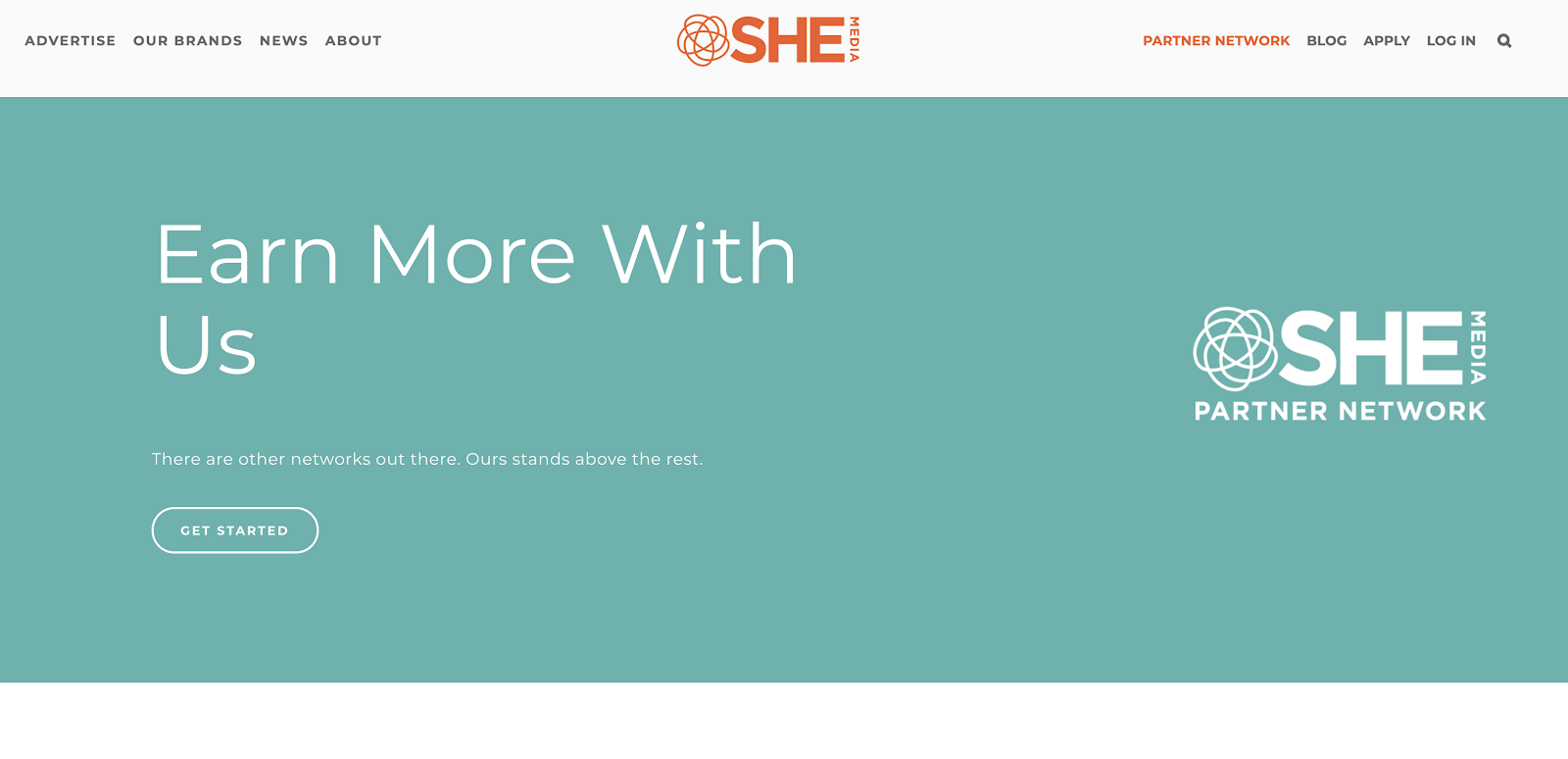
This is what the application form looks like to apply fo the SHE Media blog ad network:
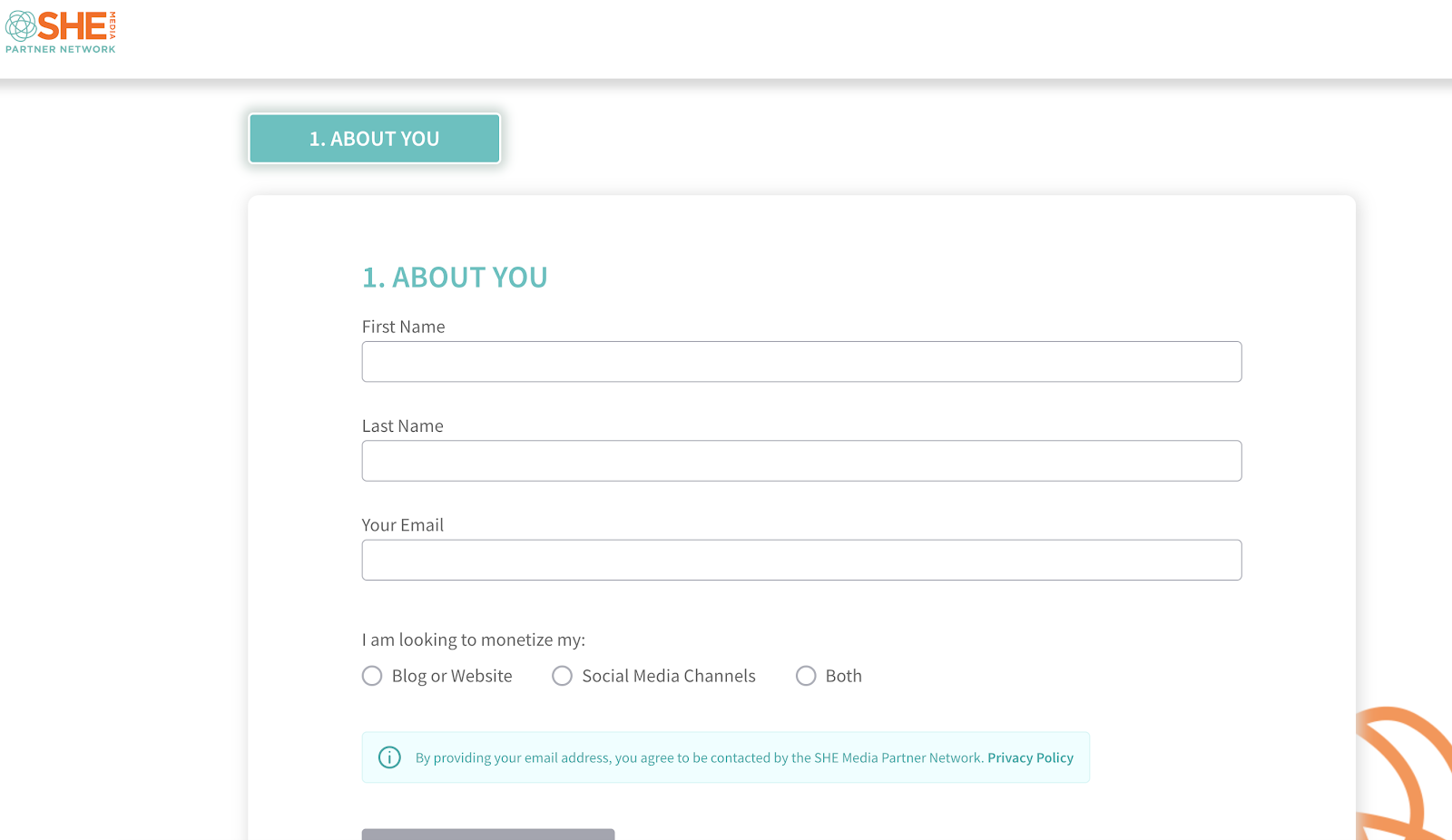
Requirements for Joining the SHE Media Blog Advertising Network
There are several things that SHE Media requires of their publishers. This is taken almost word-for-word from their FAQ page:
- Adherence to their editorial guidelines
- Sites must be brand-safe, regularly updated and at least 90 days old.
- Ideally 20K or more page views per month
- Willingness to enter into an exclusive digital ad relationship that assigns comScore to SheKnows/Penske Media Corporation
- 80%+ US-based traffic
- 70%+ Female audience
- 60%+ visibility
- 5% or less invalid traffic (IVT)
- At least two standard display ads per page
It usually takes about a week for them to manually review your website and let you know if they’re able to partner with you and accept you into their blog ad network.
Payments from SHE Media
SHE Media has a net-60 payment schedule. U.S. based partners must be paid through Direct Deposit/ACH or by check if ACH is not available. International partners are paid through PayPal. The minimum payment threshold is $20.
Pros of SHE Media
- Work on keeping your site speed up: SHE Media factors in your site speed and makes this one of their top priorities if you’re accepted into their blog advertising network. From their site: “We’re constantly optimizing our ad code and adjusting our provider list in order to maximize available speed. Keep in mind that web pages with ads will always load slower than ones without, but Boomerang is designed from the ground up to operate asynchronously. This means that the content loads first while the ads load in the background – so that visitors see your content right away. That’s the most important factor in site speed.”
- Certified Google Publishing Partner: SHE Media is a Certified Google Publishing Partner.
- Works with women: If you’re a female blogger with an audience that is primarily geared towards women, SHE Media can be a really good fit that allows for better target blog advertisements (and thus higher conversion rates).
- Opportunity to monetize your social media: SHE Media also gives partners the opportunity to monetize their social media through sponsored posts. They prefer to give this option to bloggers already using their ads.
Cons of SHE Media
- Not many payment methods are available: They’re limited on payment methods and international countries that don’t accept PayPal aren’t eligible.
- Not for all bloggers: While I also put this on the pro-list, if you’re not a female blogger or if you’re a female blogger with a very mixed audience, then SHE Media would not be a match. They also have an emphasis on the categories of parenting, food, wellness and lifestyle—which of course does not include all bloggers.
- Focus on US-based traffic: Not a good fit for bloggers receiving the majority of their traffic internationally.
- Traffic threshold: Though SHE Media doesn’t have the highest traffic threshold, it does prohibit new bloggers from applying.
Final Thoughts on Choosing the Best Blog Advertising Network (for You)

While I no longer use ads on my blog today, I can’t deny that many bloggers have been able to achieve financial freedom through the use of blog ads (myself included at one stage of my journey).
Joining the right blog advertising network can be a very good decision for you, and can plant the seeds of generating passive forms of blogging income that hopefully lead to even more scalable ways to make money blogging soon.
One of the greatest benefits of choosing to monetize your site with blog ads, is that you don’t need to write content specifically geared towards promoting a product (or an affiliate partner) and you can make money simply because people visit your site to read what you want to talk about. In that sense, blog ads can actually lead to one of the most pure forms of profitable blogging.
So, what’s your blog advertising network of choice? Who would you add to this list that I’m missing?
Do you have a success story of using blog ads to monetize your own audience?
Share with me in the comments below, I’d love to hear from you!

55 replies to “9 Best Blog Ad Networks (to Make Money with Blog Advertisements) in 2025: Do Blog Ads Make Money Still?”
This is a very interesting article. Looking forward for more content like this. Please keep posting!
Superb article, have a lot of information, love that
That is very useful!
Thanks for sharing this I found your information really helpful, your explanations were easy to follow, and I appreciated how you explain about these ad networks.
this post is very informative and helpful.
hello, thanks for this informative article.
Revenuehits is no longer revenuehits
aha! thanks for the heads up, just removed them 🤘
I tried my hand on Seo for my website but could not get success what was looking so person need to take a help of professional.
Great! Very interesting article. Looking forward for more content like this. Keep posting!
You got it!
Fantastic article! Your insights are always spot on and incredibly helpful. I appreciate the effort you put into providing such valuable content.
thanks for the love! 🙏
The guide provides valuable insights into monetizing a blog with ads, acknowledging both the benefits and drawbacks of this method. It highlights the best blog advertising networks and offers clear, actionable advice for beginners. The inclusion of affiliate links is transparent, supporting the blog while keeping content free for readers.
Thank you for sharing your knowledge with me. As someone who is starting a career in SEO, I truly understand how valuable this information is.
superb thanks for sharing this
Great! Very engaging article. Looking forward to more content like this. Keep sharing!
Great guide! I love the detailed breakdown of ad networks like Mediavine and Monumetric. Mediavine’s higher payouts are appealing, but the traffic requirements might be tough for newer bloggers. Monumetric offers more flexibility, which is great for growing sites. This is super helpful for anyone looking to monetize their blog – thanks for sharing!